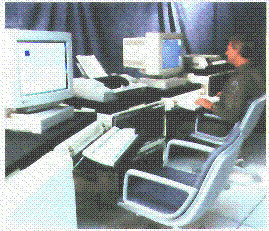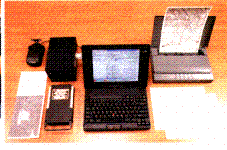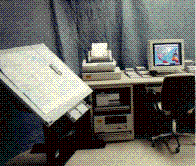


Air Force Mission Support System (AFMSS)
 The Air Force Mission Support System (AFMSS) provides automated mission-planning support for Air
Force aircraft (fixed and rotary wing) and guided munitions. AFMSS will operate either as a stand-alone
system, or linked with other command information systems, to aid the mission planner in selecting an
optimal route through hostile territory. AFMSS is expected to significantly benefit command and control
performance by enhancing information superiority for the warfighter and by providing unique
capabilities in support of both precision engagement and dominant maneuver.
Aircraft Mission Planning is the creation of a flight
plan which takes into account terrain, weather,
aircraft performance capability and configuration. The
planner must have the ability to plan weapon and/or
cargo delivery, calculate fuel requirements, and assess
the route based on known enemy threat location and
type. In addition, a planner must be able to de-conflict
flight routes with other aircraft, review, print and brief
the mission plan to Command and download pertinent
flight information to on-board aircraft avionics. The
Air Force Mission Support Systems (AFMSS) provides
all of this and more, through it's Family of mission
planning products.
AFMSS consists of computer and software tools that support aircraft and weapon mission planning.
AFMSS uses several different hardware versions, all comprising commercially available off-the-shelf
components. For aircraft with electronic data transfer capability, aircraft-unique hardware peripherals are
used to prepare data transfer devices for uploading mission information into aircraft computers. AFMSS
core software is combined with tailored Aircraft/Weapon/Electronics modules to provide a Mission
Planning System (MPS) for each aircraft type. Low observable aircraft also require a software module
called Common Low Observable Autorouter (CLOAR) to plan routes that minimize exposure to threat
systems. The outputs of AFMSS-based MPSs are combat mission folders (comprising maps, images, and
flight information) and data transfer devices.
AFMSS, comprised of the Portable Flight Planning System (PFPS), the Mission
Planning System (MPS) and the Portable Mission Planning System (PMPS),
provides an integrated environment supporting all missions and aircraft.
Mission planning tools include:
The Air Force Mission Support System (AFMSS) provides automated mission-planning support for Air
Force aircraft (fixed and rotary wing) and guided munitions. AFMSS will operate either as a stand-alone
system, or linked with other command information systems, to aid the mission planner in selecting an
optimal route through hostile territory. AFMSS is expected to significantly benefit command and control
performance by enhancing information superiority for the warfighter and by providing unique
capabilities in support of both precision engagement and dominant maneuver.
Aircraft Mission Planning is the creation of a flight
plan which takes into account terrain, weather,
aircraft performance capability and configuration. The
planner must have the ability to plan weapon and/or
cargo delivery, calculate fuel requirements, and assess
the route based on known enemy threat location and
type. In addition, a planner must be able to de-conflict
flight routes with other aircraft, review, print and brief
the mission plan to Command and download pertinent
flight information to on-board aircraft avionics. The
Air Force Mission Support Systems (AFMSS) provides
all of this and more, through it's Family of mission
planning products.
AFMSS consists of computer and software tools that support aircraft and weapon mission planning.
AFMSS uses several different hardware versions, all comprising commercially available off-the-shelf
components. For aircraft with electronic data transfer capability, aircraft-unique hardware peripherals are
used to prepare data transfer devices for uploading mission information into aircraft computers. AFMSS
core software is combined with tailored Aircraft/Weapon/Electronics modules to provide a Mission
Planning System (MPS) for each aircraft type. Low observable aircraft also require a software module
called Common Low Observable Autorouter (CLOAR) to plan routes that minimize exposure to threat
systems. The outputs of AFMSS-based MPSs are combat mission folders (comprising maps, images, and
flight information) and data transfer devices.
AFMSS, comprised of the Portable Flight Planning System (PFPS), the Mission
Planning System (MPS) and the Portable Mission Planning System (PMPS),
provides an integrated environment supporting all missions and aircraft.
Mission planning tools include:
- Flight, Route and Airdrop Planning
- Weapons Delivery
- Target Area Planning
- Radar Predictions
- Threat analysis
- Route Fly Through
- Perspective Views
- Cartridge/Data Transfer Devices (DTDs) Loading
 AFMSS Mission Planning System (MPS) mission planning tools use an X Window graphical user interface which are installed on commercially available workstations. The MPS tools expand Portable Flight Planning Systems (PFPS) capability to include:Interoperability with Theater Battle Management (TBM) Systems allowing for Air Tasking Orders, intelligence and imagery updates; Threat Analysis; Autorouting; Combat Mission Folder production; Terrain Based Radar Predictions; Imagery; and Terrain Based Perspective Views.
AFMSS Mission Planning System (MPS) mission planning tools use an X Window graphical user interface which are installed on commercially available workstations. The MPS tools expand Portable Flight Planning Systems (PFPS) capability to include:Interoperability with Theater Battle Management (TBM) Systems allowing for Air Tasking Orders, intelligence and imagery updates; Threat Analysis; Autorouting; Combat Mission Folder production; Terrain Based Radar Predictions; Imagery; and Terrain Based Perspective Views.
 Mission Planning System (MPS) II performance enhancements (as compared to the MPS) include print times reduced up to 50% for strip charts; CD-ROM performance increases by 30% while running MDI Import; and EO performance increases over 600% for Read and Write during MDI import.
Mission Planning System (MPS) II performance enhancements (as compared to the MPS) include print times reduced up to 50% for strip charts; CD-ROM performance increases by 30% while running MDI Import; and EO performance increases over 600% for Read and Write during MDI import.
 Portable Mission Planning System (PMPS) provides the software features of the MPS in a smaller, portable, lightweight configuration while maintaining full printing and data transfer services of the MPS. Planners can select from a number of portable workstations and accessories to tailor the PMPS to their warfare needs.
Portable Mission Planning System (PMPS) provides the software features of the MPS in a smaller, portable, lightweight configuration while maintaining full printing and data transfer services of the MPS. Planners can select from a number of portable workstations and accessories to tailor the PMPS to their warfare needs.
 Portable Flight Planning System (PFPS) mission planning tools are integrated under a common consistent Micosoft Windows Graphical-User-Interface and can be installed on commercially available desktop and portable computer systems. Primary outputs include: Custom Kneeboard Cards; Combat Mission Folders and Data Transfer Services. PFPS is comprised of the following software components: Combat Flight Planning System (CFPS) Providing Route Editing functions through an Interactive Flight Log (IFL); Combat Weapons and Delivery System (CWDS) Providing weapon delivery planning capability; Combat Airdrop Planning System (CAPS) Providing Airdrop planning capability and Drop Zone data; FalconView - Produced by Georgia Tech, provides the Mapping and Overlay drawing capabilities ; Combat Target Planning System (CTPS) Providing an electronic Joint Munitions Effectiveness Manual (JMEM) Variety of aircraft cartridge cutting software providing the capability to download the aircraft avionics with flight information.
Portable Flight Planning System (PFPS) mission planning tools are integrated under a common consistent Micosoft Windows Graphical-User-Interface and can be installed on commercially available desktop and portable computer systems. Primary outputs include: Custom Kneeboard Cards; Combat Mission Folders and Data Transfer Services. PFPS is comprised of the following software components: Combat Flight Planning System (CFPS) Providing Route Editing functions through an Interactive Flight Log (IFL); Combat Weapons and Delivery System (CWDS) Providing weapon delivery planning capability; Combat Airdrop Planning System (CAPS) Providing Airdrop planning capability and Drop Zone data; FalconView - Produced by Georgia Tech, provides the Mapping and Overlay drawing capabilities ; Combat Target Planning System (CTPS) Providing an electronic Joint Munitions Effectiveness Manual (JMEM) Variety of aircraft cartridge cutting software providing the capability to download the aircraft avionics with flight information.
- Special Operations Forces Planning And Rehearsal
System (SOFPARS) was developed to reduce the size and weight of the existing mission planning products with Commercial Off The Shelf (COTS) Non-Developmental Item
(NDI) -based, open system architecture mission planning products.
 The Common Mapping Production System (CMPS)
provides capability to produce standardized mapping, charting,
Geodesy and Imagery (MCG&I) products used in mission
planning systems. It enables users to import data derived from
standard military digital cartographic products on distribution
media organized for use in measurement, display and related
manipulations. CMPS will make Compressed Mapping (55:1) and
imagery (8:1) data for joint MCG&I Users. CMPS will also
provide capability to digitally update maps (DCHUM).
The Common Mapping Production System (CMPS)
provides capability to produce standardized mapping, charting,
Geodesy and Imagery (MCG&I) products used in mission
planning systems. It enables users to import data derived from
standard military digital cartographic products on distribution
media organized for use in measurement, display and related
manipulations. CMPS will make Compressed Mapping (55:1) and
imagery (8:1) data for joint MCG&I Users. CMPS will also
provide capability to digitally update maps (DCHUM).
The AFMSS program began in 1990. An interim version, Block C1.5, is fielded for six USAF aircraft
types. Block C2.0 software completed development in 2QFY97 and is currently undergoing operational
test and evaluation (OT&E) for the following aircraft types: B-2, F-117, KC-135R, F-15E with
AGM-130, B-52H, A-10, F-15 MSIP, C-27, EF-111, F-16C/D Block 40/50, C-130E/H, and
C-130P/N. Block C2.1 software merges requirements of Air Force aircraft and those of the U.S. Special
Operations Command into a common software version. Block C2.1 software is completing development
and will undergo OT&E during FY98 on the following aircraft types: MC-130E, HH/MH-60G, C-17,
B-1B, RC-135V/U, E-8, MC-130H, MH-53J, AC-130H, MC-130P, EC-130H, and AC-130U.
Special Focus areas include the Common Low Observable Auto Router (CLOAR) - and the integration of the CLOAR with AFMSS products. CLOAR
provides autorouting and threat analysis capability to low observable airframes including F-111A, F-22 and the B-2.
Sources and Resources
http://www.fas.org/man/dod-101/sys/ac/equip/afmss.htm
Maintained by Robert Sherman
Originally created by John Pike
Updated Saturday, January 09, 1999 10:27:01 AM
 AFMSS Mission Planning System (MPS) mission planning tools use an X Window graphical user interface which are installed on commercially available workstations. The MPS tools expand Portable Flight Planning Systems (PFPS) capability to include:Interoperability with Theater Battle Management (TBM) Systems allowing for Air Tasking Orders, intelligence and imagery updates; Threat Analysis; Autorouting; Combat Mission Folder production; Terrain Based Radar Predictions; Imagery; and Terrain Based Perspective Views.
AFMSS Mission Planning System (MPS) mission planning tools use an X Window graphical user interface which are installed on commercially available workstations. The MPS tools expand Portable Flight Planning Systems (PFPS) capability to include:Interoperability with Theater Battle Management (TBM) Systems allowing for Air Tasking Orders, intelligence and imagery updates; Threat Analysis; Autorouting; Combat Mission Folder production; Terrain Based Radar Predictions; Imagery; and Terrain Based Perspective Views.
 Mission Planning System (MPS) II performance enhancements (as compared to the MPS) include print times reduced up to 50% for strip charts; CD-ROM performance increases by 30% while running MDI Import; and EO performance increases over 600% for Read and Write during MDI import.
Mission Planning System (MPS) II performance enhancements (as compared to the MPS) include print times reduced up to 50% for strip charts; CD-ROM performance increases by 30% while running MDI Import; and EO performance increases over 600% for Read and Write during MDI import.
 Portable Mission Planning System (PMPS) provides the software features of the MPS in a smaller, portable, lightweight configuration while maintaining full printing and data transfer services of the MPS. Planners can select from a number of portable workstations and accessories to tailor the PMPS to their warfare needs.
Portable Mission Planning System (PMPS) provides the software features of the MPS in a smaller, portable, lightweight configuration while maintaining full printing and data transfer services of the MPS. Planners can select from a number of portable workstations and accessories to tailor the PMPS to their warfare needs.
 Portable Flight Planning System (PFPS) mission planning tools are integrated under a common consistent Micosoft Windows Graphical-User-Interface and can be installed on commercially available desktop and portable computer systems. Primary outputs include: Custom Kneeboard Cards; Combat Mission Folders and Data Transfer Services. PFPS is comprised of the following software components: Combat Flight Planning System (CFPS) Providing Route Editing functions through an Interactive Flight Log (IFL); Combat Weapons and Delivery System (CWDS) Providing weapon delivery planning capability; Combat Airdrop Planning System (CAPS) Providing Airdrop planning capability and Drop Zone data; FalconView - Produced by Georgia Tech, provides the Mapping and Overlay drawing capabilities ; Combat Target Planning System (CTPS) Providing an electronic Joint Munitions Effectiveness Manual (JMEM) Variety of aircraft cartridge cutting software providing the capability to download the aircraft avionics with flight information.
Portable Flight Planning System (PFPS) mission planning tools are integrated under a common consistent Micosoft Windows Graphical-User-Interface and can be installed on commercially available desktop and portable computer systems. Primary outputs include: Custom Kneeboard Cards; Combat Mission Folders and Data Transfer Services. PFPS is comprised of the following software components: Combat Flight Planning System (CFPS) Providing Route Editing functions through an Interactive Flight Log (IFL); Combat Weapons and Delivery System (CWDS) Providing weapon delivery planning capability; Combat Airdrop Planning System (CAPS) Providing Airdrop planning capability and Drop Zone data; FalconView - Produced by Georgia Tech, provides the Mapping and Overlay drawing capabilities ; Combat Target Planning System (CTPS) Providing an electronic Joint Munitions Effectiveness Manual (JMEM) Variety of aircraft cartridge cutting software providing the capability to download the aircraft avionics with flight information.
 The Common Mapping Production System (CMPS)
provides capability to produce standardized mapping, charting,
Geodesy and Imagery (MCG&I) products used in mission
planning systems. It enables users to import data derived from
standard military digital cartographic products on distribution
media organized for use in measurement, display and related
manipulations. CMPS will make Compressed Mapping (55:1) and
imagery (8:1) data for joint MCG&I Users. CMPS will also
provide capability to digitally update maps (DCHUM).
The Common Mapping Production System (CMPS)
provides capability to produce standardized mapping, charting,
Geodesy and Imagery (MCG&I) products used in mission
planning systems. It enables users to import data derived from
standard military digital cartographic products on distribution
media organized for use in measurement, display and related
manipulations. CMPS will make Compressed Mapping (55:1) and
imagery (8:1) data for joint MCG&I Users. CMPS will also
provide capability to digitally update maps (DCHUM).



 The Air Force Mission Support System (AFMSS) provides automated mission-planning support for Air
Force aircraft (fixed and rotary wing) and guided munitions. AFMSS will operate either as a stand-alone
system, or linked with other command information systems, to aid the mission planner in selecting an
optimal route through hostile territory. AFMSS is expected to significantly benefit command and control
performance by enhancing information superiority for the warfighter and by providing unique
capabilities in support of both precision engagement and dominant maneuver.
Aircraft Mission Planning is the creation of a flight
plan which takes into account terrain, weather,
aircraft performance capability and configuration. The
planner must have the ability to plan weapon and/or
cargo delivery, calculate fuel requirements, and assess
the route based on known enemy threat location and
type. In addition, a planner must be able to de-conflict
flight routes with other aircraft, review, print and brief
the mission plan to Command and download pertinent
flight information to on-board aircraft avionics. The
Air Force Mission Support Systems (AFMSS) provides
all of this and more, through it's Family of mission
planning products.
AFMSS consists of computer and software tools that support aircraft and weapon mission planning.
AFMSS uses several different hardware versions, all comprising commercially available off-the-shelf
components. For aircraft with electronic data transfer capability, aircraft-unique hardware peripherals are
used to prepare data transfer devices for uploading mission information into aircraft computers. AFMSS
core software is combined with tailored Aircraft/Weapon/Electronics modules to provide a Mission
Planning System (MPS) for each aircraft type. Low observable aircraft also require a software module
called Common Low Observable Autorouter (CLOAR) to plan routes that minimize exposure to threat
systems. The outputs of AFMSS-based MPSs are combat mission folders (comprising maps, images, and
flight information) and data transfer devices.
AFMSS, comprised of the Portable Flight Planning System (PFPS), the Mission
Planning System (MPS) and the Portable Mission Planning System (PMPS),
provides an integrated environment supporting all missions and aircraft.
Mission planning tools include:
The Air Force Mission Support System (AFMSS) provides automated mission-planning support for Air
Force aircraft (fixed and rotary wing) and guided munitions. AFMSS will operate either as a stand-alone
system, or linked with other command information systems, to aid the mission planner in selecting an
optimal route through hostile territory. AFMSS is expected to significantly benefit command and control
performance by enhancing information superiority for the warfighter and by providing unique
capabilities in support of both precision engagement and dominant maneuver.
Aircraft Mission Planning is the creation of a flight
plan which takes into account terrain, weather,
aircraft performance capability and configuration. The
planner must have the ability to plan weapon and/or
cargo delivery, calculate fuel requirements, and assess
the route based on known enemy threat location and
type. In addition, a planner must be able to de-conflict
flight routes with other aircraft, review, print and brief
the mission plan to Command and download pertinent
flight information to on-board aircraft avionics. The
Air Force Mission Support Systems (AFMSS) provides
all of this and more, through it's Family of mission
planning products.
AFMSS consists of computer and software tools that support aircraft and weapon mission planning.
AFMSS uses several different hardware versions, all comprising commercially available off-the-shelf
components. For aircraft with electronic data transfer capability, aircraft-unique hardware peripherals are
used to prepare data transfer devices for uploading mission information into aircraft computers. AFMSS
core software is combined with tailored Aircraft/Weapon/Electronics modules to provide a Mission
Planning System (MPS) for each aircraft type. Low observable aircraft also require a software module
called Common Low Observable Autorouter (CLOAR) to plan routes that minimize exposure to threat
systems. The outputs of AFMSS-based MPSs are combat mission folders (comprising maps, images, and
flight information) and data transfer devices.
AFMSS, comprised of the Portable Flight Planning System (PFPS), the Mission
Planning System (MPS) and the Portable Mission Planning System (PMPS),
provides an integrated environment supporting all missions and aircraft.
Mission planning tools include: